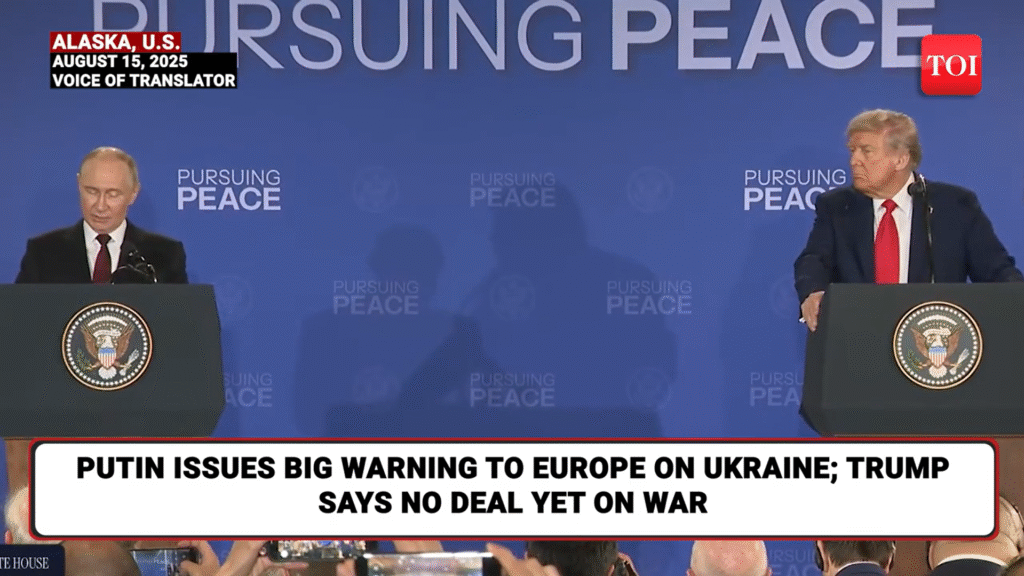Trump–Putin Summit Ends Without Breakthrough: India Caught in the Middle of Global Uncertainty

Image via Times Of India
Date: August 16, 2025
The much-anticipated meeting between U.S. President Donald Trump and Russian President Vladimir Putin concluded on August 16, 2025, at a military base in Alaska. Hopes were high that the summit could deliver a breakthrough on Ukraine and reset strained global relations. Instead, the talks ended without a deal, leaving many countries — especially India — facing tough questions about their foreign policy choices.
Both leaders exchanged warm words and called the meeting “productive.” Yet behind the cameras and friendly gestures, there was no progress on core issues. No ceasefire. No peace roadmap. No concrete plan. For India, which depends on balancing ties with both powers, the inconclusive outcome has created a cloud of uncertainty.
1. The Summit of Words, Not Results
The Alaska summit was framed as a “moment of opportunity.” For weeks, global headlines suggested that Trump might push Putin toward a ceasefire in Ukraine. Instead, the leaders stopped short of any written agreement.
President Trump told reporters, “We made some headway. But there’s no deal until there’s a deal.” Putin smiled and hinted at a future meeting in Moscow. Trump did not refuse, but his response remained vague.
Analysts say the event was more about optics than action. The handshake photos, military backdrop, and formal dinners made headlines. But beneath the grand stagecraft, the outcome was empty.
2. Why India Is in Limbo
The Times of India described the situation simply: “India is in limbo.” The phrase captures the reality. India’s strategy of “strategic autonomy” now faces fresh challenges.
- Defence: India remains one of Russia’s largest buyers of arms. From fighter jets to missile systems, Moscow supplies critical equipment. Any disruption in U.S.–Russia ties risks slowing down India’s defence modernization.
- Energy: Russia has also become a key energy partner. Discounted Russian oil kept India’s energy bills lower in recent years. But President Trump has openly discouraged India from buying Russian crude, warning of tariffs and penalties.
- Trade: At the same time, India cannot afford to alienate the U.S. Washington is one of New Delhi’s biggest trade partners. Recently, the Trump administration even slapped an extra 25% tariff on Indian goods, putting further strain on ties.
For India, the inconclusive summit means that global pressure will only intensify. With no clear peace plan, New Delhi must keep juggling its relationships — without tipping the balance.
3. What Indian Leaders Might Be Thinking
Indian policymakers are likely weighing their options carefully. India does not want to be seen as siding with either camp. At the same time, it cannot ignore the economic and political costs.
- Neutrality under pressure – India has so far tried to remain neutral on Ukraine. But neutrality is becoming harder as the U.S. raises costs for countries still trading with Moscow.
- Risk to energy security – If U.S. tariffs expand or sanctions tighten, India may lose access to cheap Russian oil. That would hit households and industries back home.
- Defence supply chains – Indian forces rely heavily on spare parts and systems from Russia. Any freeze in trade could disrupt military readiness.
- Domestic politics – With national elections approaching in 2026, Indian leaders must show they can protect jobs, growth, and national security. Foreign policy risks quickly become political risks.
4. A Global Stage, but No Global Solutions
The Trump–Putin summit showed the limits of personal diplomacy. Both leaders spoke of “friendship” and “understanding,” but no one walked away with a plan. For Ukraine, that means more uncertainty. For Europe, more instability. And for India, more hesitation.
Reuters summed it up clearly: “Warm words contrasted with the cold reality of no deal.” Leaders in Europe, NATO, and Ukraine expressed frustration. They expected a shift. They got photo opportunities instead.
India, watching from afar, now faces the same frustration. A dramatic event took place. But nothing changed.
5. Possible Scenarios for India
What lies ahead for India after this inconclusive summit? Analysts suggest a few possible outcomes:
- More U.S. pressure: Trump could expand tariffs or threaten sanctions if India continues buying Russian oil.
- Deeper Russian ties: If the West pushes harder, India may quietly strengthen defence and energy cooperation with Moscow to protect its interests.
- Seeking middle ground: India may also step up its diplomacy, reaching out to Europe and Asia to soften U.S. pressure while keeping Russian supplies open.
- Focus on self-reliance: These tensions may accelerate India’s push for defence and energy self-reliance. Reducing dependence on either bloc could become a long-term strategy.
6. India’s Balancing Act
India has walked this tightrope before. During the Cold War, it balanced ties with the U.S. and the Soviet Union. In the 21st century, it has built strong bonds with both Washington and Moscow. But the Ukraine crisis has reopened old dilemmas.
New Delhi knows it cannot anger Washington, which supports India against China in the Indo-Pacific. At the same time, it cannot afford to abandon Russia, which has been a steady partner for decades.
The inconclusive Trump–Putin talks did not solve India’s problem. They made it sharper.
7. Looking Ahead
The next steps remain unclear. Trump hinted he would speak with Ukraine’s President Zelenskyy and NATO allies. Putin hinted at hosting Trump in Moscow. But neither gave details.
For India, this means waiting and watching. The government must prepare for shifting trade rules, rising global oil prices, and the possibility of tighter sanctions. Diplomacy will remain India’s most powerful tool.